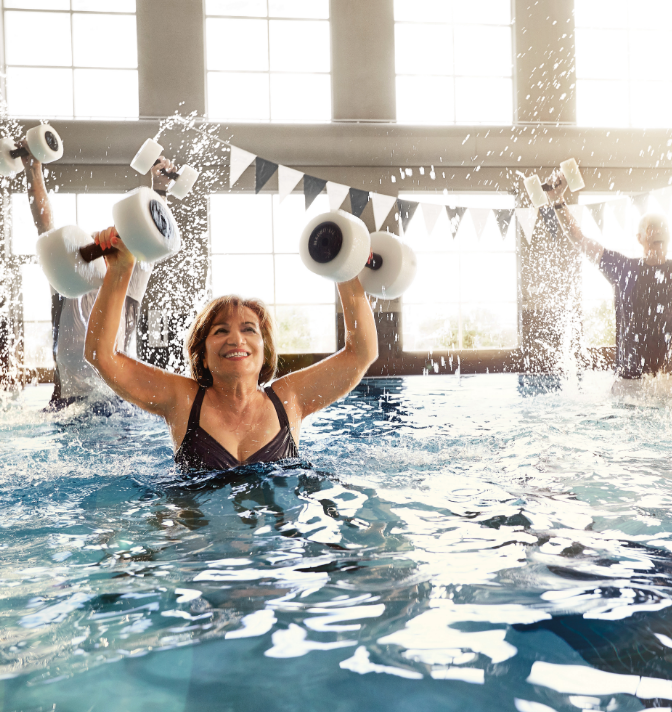Many experts tout the benefits of strength training, especially as we get older. Muscle loss is a reality of aging, and our bodies can become more susceptible to injury as a result. This is why more older adults are turning to strength training and continuing to do the activities they love.
Unless you’ve been lifting weights consistently for some time, it’s best to start conservatively. “When people join a health club for the first time, they may feel overwhelmed seeing people doing heavy lifting with barbells and other more advanced equipment,” says Lance Johnson, an ARORA-certified Dynamic Personal Trainer at Life Time. “It can be intimidating, so I recommend consulting a certified trainer to help you take a step back and figure out a starting point that works best for you.”
We asked Johnson for advice when it comes to starting a strength-training program as a beginner or someone with mobility limitation.
1. Meet with a personal trainer.
If you’re new to exercising or a certain type of exercise, or are working with injuries or body limitations, it’s best to consult the experts. “An ARORA-certified trainer is an extra set of eyes to make sure you’re using safe and proper form when strength training, and they can help you make the most of your workout,” says Johnson. “They can help you avoid mistakes — like using too heavy of a weight, completing too many reps, or having incorrect form — that might cause you injury.”
2. Start with light weights.
You might be tempted to pick up heavy weights to get results, but Johnson recommends going light to avoid injury. “I would rather err on the side of ‘too light’ than risk injury with something that’s too heavy,” he says. “You can always add weight as you progress and get stronger.
“I see people get super excited about a new workout program and end up pushing themselves too hard,” he continues. “A trainer can help you find the right starting point to get your body used to strength training so you’re able to continue with a more sustainable workout plan.”
3. Consider ditching the barbell.
Many trainers view a barbell as a more advanced piece of strength-training equipment. For beginners, Johnson recommends switching out the barbell for dumbbells for most exercises, especially the following:
Deadlifts
“The risk-to-reward ratio on a barbell deadlift for a beginner is very high as it’s much easier to use a weight that’s too heavy for you,” says Johnson. “As an alternative, I recommend using a dumbbell in each hand. Dumbbells allow for a more flexible hand and wrist placement to make it easier on your joints.”
Bench Press
“When you hold a straight barbell with both of your hands in a pressing motion — think bench press or overhead press — it locks your joints into the motion of the bar, which can put unwanted pressure on your wrist, elbow, and shoulder joints,” he explains. “An easy modification is to use a pair of dumbbells. To protect your joints, be sure to keep your upper arms at a 45-degree angle from your body as you lower the dumbbells.”
Back Squat
For someone just beginning their strength-training journey, the barbell back squat can be a more advanced move. “A great alternative to the barbell back squat is using one heavy dumbbell for a goblet squat,” says Johnson. “For more stability assistance, you can also try adding a box behind you to sit on as you lower yourself down into a squat position.”
4. Be careful to not overdo it.
Johnson stresses the importance of taking it slow as a beginner. “A huge pitfall for people just starting out on a fitness journey is simply doing too much too soon,” he says. “Getting the results you want hinges on allowing your body to rest and recover. And as we get older, that process can take longer. You may need to take a day or more off between exercise sessions to let your body rest and catch up.”
4 Cardio Exercises for Healthy Aging
It’s critical to balance your strength-training efforts with cardiovascular work for a well-rounded routine. Low-impact workouts are a great way to reach your goals without too much strain on your joints.
“If you’re working out at Life Time, you may see people doing some form of sprinting on a treadmill or track, which is higher impact” says Johnson. “For beginners, I suggest doing your cardio on a stationary bike or elliptical for a lower-impact option. An easy format to follow is to push hard for 30 seconds followed by two minutes rest. Do this eight times for a great conditioning workout.”
You can also try these other low-impact options:
Swimming
As we age, our joints experience more wear and tear. The great thing about swimming is that, in contrast to running, it’s easier on our joints and the water allows us to stay active without as much mechanical pressure.
Aqua classes that elevate your heart rate in a swimming pool are a great way to get in a workout while also connecting with community. But it’s also OK to switch things up and swim laps solo. If you’ve never done so, consider taking a few swimming lessons to learn about proper form.
Another benefit of building endurance through swimming is that it forces you to fully disconnect from your phone and social media.
Cycling
When it comes to a well-rounded cardio routine, it’s crucial to safely incorporate high-intensity interval training (HIIT) — or what feels like about 80- to 90-percent effort — one to two times per week. This strengthens the heart and increases your VO2 score, a marker that’s tied to all-cause mortality. (Read more here: “How to Increase Your VO2 Score”)
For many people, interval training on a treadmill can be hard on their knees. Using a stationary bike with added resistance is a great way to incorporate HIIT training without the jarring, pounding impact of gravity that can happen in other modalities.
Pickleball
There’s something to be said for having fun while exercising, which is why incorporating nontraditional methods of cardiovascular training can be effective. Pickleball continues to rise in popularity, and one reason is because it can provide a great workout that doesn’t feel like exercise — often thanks to the social element it provides. The time passes quickly, allowing more total active minutes per week and helping you reach the recommended goal of 180 minutes per week.
Walking
Low-intensity exercise is pivotal to building endurance, though it’s often neglected because it doesn’t always feel acutely challenging. (Read more about here: “Becoming an Effective Fat Burner: How to Build Your Aerobic Base”)
Lower-intensity work — somewhere in the range of a three to five intensity on a one to 10 scale (with one feeling like you could go all day and 10 representing your maximum effort) — sets the foundation for your endurance and aerobic capacity. It trains your body’s engine, so to speak, to burn fat more efficiently and to better recover from higher-intensity efforts.
If walking by itself feels like it’s not quite at that three to five out of 10 effort, try doing speed walking or incline work.





